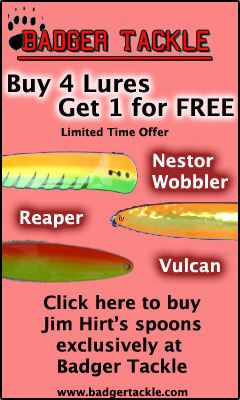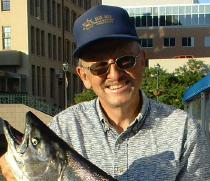Fishing the Zone for Coho Salmon #3
Let me explain how to be more productive by following some basic rules and using basic tools. Activity and habits of fish are dictated by many variables. A rather basic approach will put you on fish and keep you there. I will cover how to find the most productive zones by species. Article number one and two covered Chinook and Brown Trout. Now let’s look at Coho Salmon as it applies to Lake Michigan and other big water ecosystems. Get caught up by reading article number one titled Fishing The Zone For Salmon Milwaukee #1. This information is necessary to understand the following article.
Zones By Species
Lake Michigan Milwaukee is an outstanding fishery with many options for anglers. The most popular targets of anglers here are Chinook salmon, Coho Salmon, Rainbow Trout, Brown Trout and Lake Trout. Allow me to offer environmental preferences for each of these. Breaking each fish down by their preferences is the best way to find steady consistent action on any fish.
Coho Salmon Zone By Temperature
Coho offer great action with the reward of some of the best eating of all Lake Michigan fish. Once again the answer to putting them in the box is temperature. Look for them in temperatures above 50 degrees up to 57 degrees. Exceptions to this temp zone are possible but not the norm. As they come in to spawn they will be less sensitive to temperature. They will tolerate colder water and temperatures below 50, however they are less active.
Location And Forage
The principal types of forage for all fish in Lake Michigan are the Alewife and Goby. Look for pods of forage for consistent action. I have caught Coho at all depths all season long. Don’t make the mistake of not running tackle for them, but they do require a different approach. Most consistent action is in the spring months of May and June. The reason for this is the water is very cold and the top water is the best habitat for them. The shallow water, or the top 25 feet where warm water has accumulated, is the answer to your best numbers. Early May run your baits in the top five feet and progress to deeper in the water column as the water warms up. The reason for outstanding spring fishing for Coho is that the cold water of Lake Michigan concentrates them. Finding a temperature break is the key to finding fish. A break is defined as a major or minor change in water temperature. At times a small change of a degree or two will hold fish, but I have found the greater the change the better the concentration of fish. In spring the Coho that have wintered on the southern end of Lake Michigan will migrate north. You will find some action near shore and this is a good starting spot. My experience is deep water can be very productive. I fish out to ten miles off shore in 250 feet of water for fantastic action and limits on this exciting spring fish.
Presentations For Limits On Coho Salmon
Anytime of day is a good time for this quarry. I categorize them as day feeders with angling success all day. Water temperature will dictate your best bait. I will break this down by temperature. Below 50 degrees use small crankbaits, minnow type lures and small spoons like the regular size Vulcan in silver or bright colors sold by Badger Tackle. Above 50 the cold water baits will produce but not as well as six inch orange flashers or dodgers with flies or squids. The distance between the attractor and the fly or squid will vary with the temp of the water. Try one and a half times the length of the flasher or about nine inches up to eighteen inches. Longer lead on the fly seems to work better in colder water. You may catch some fish on downriggers but they are not my first choice for presentation. Church Tackle Walleye Boards are the way to go. I run four or more on each side of the boat working an area over three hundred feet wide. Set up for Coho with a six foot 15 pound leader tied to a 3/8-ounce keel sinker attached to the 20-pound main line to your reel. Baits are attached with a ball bearing snap and ran 25 feet behind the planner board. The planer board will run well off to the side of the boat out of your travel path.
Hot Lures Define The Day
Let’s wrap this up with my favorite lures. For spring crankbaits, minnow type lures and small spoons like the regular size Vulcan or six inch orange flashers and dodgers with flies or squids. Later in the season go to larger 8 inch dodgers and flies along with all size spoons in silver green. Magnum Reaper spoons did very well for us later in the season on Coho recent years. Baitfish size should be considered when selecting your spoon size. Vulcan and Reaper spoons are both sold by http://www.badgertackle.com I will continue with Zones for Rainbow Trout in the next article. Good Luck! Jim charters out of Milwaukee, WI. with Blue Max Charters. He can be reached at 414-828-1094 or visit his web site at http://www.bluemaxcharters.com Copyright© 2009, James J. Hirt, All Rights Reserved





